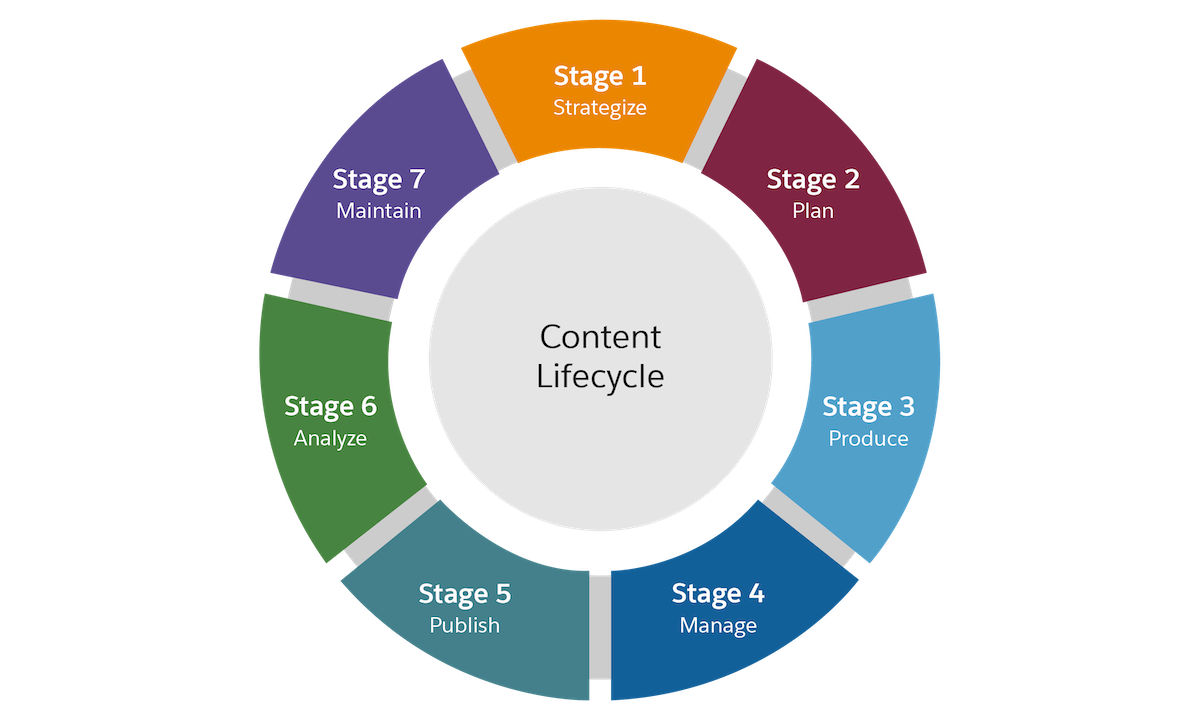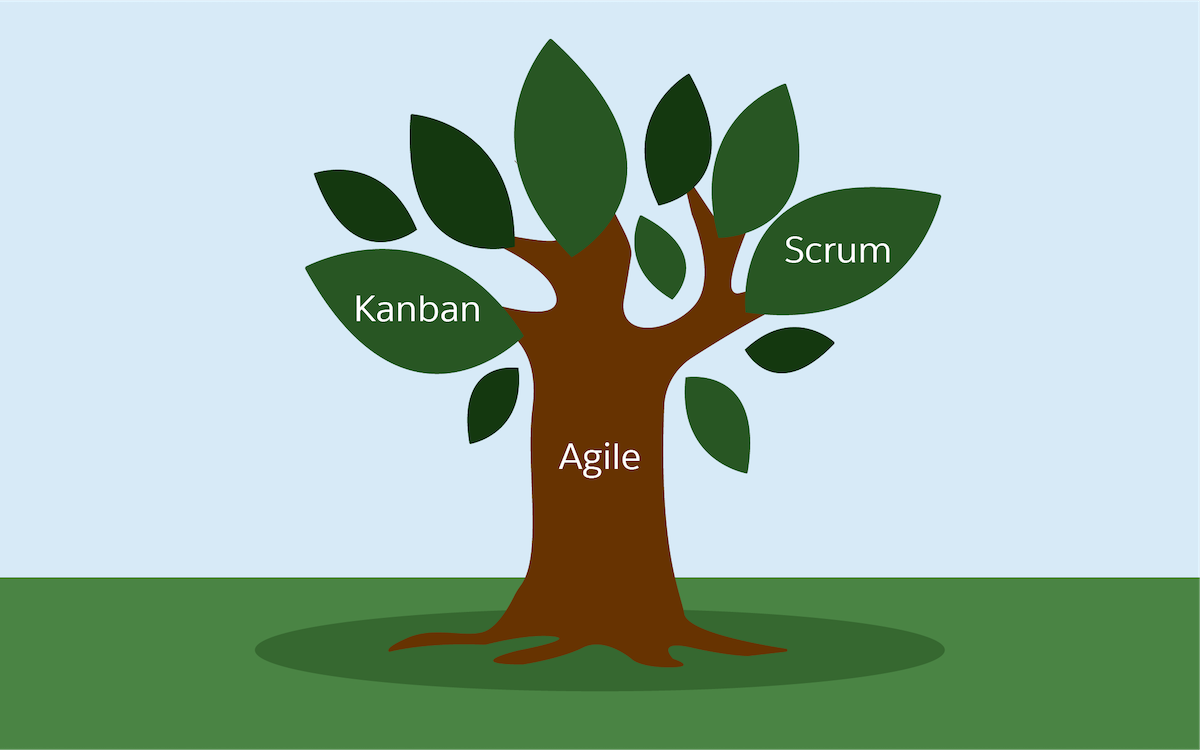Establish Content Processes
Learning Objectives
After completing this unit, you’ll be able to:
- Describe the stages of the content lifecycle.
- Design your team’s content workflow.
- Define agile development.
- List the benefits of adopting agile processes.
- Develop internal content documentation.
How Content Is Made
In the beginning, a piece of content is just a twinkle in your organization’s eye. Eventually, that content is delivered to your audience so it can guide, inform, inspire, persuade, or delight them. But what exactly happens in between?
That’s defined by your content workflow, which is the series of steps required to take a piece of content from its earliest inception all the way to its publication and maintenance. In this unit, you learn about the stages of the development process and how that process ultimately shapes the quality of your content.
Plot the Content Lifecycle
It can be helpful to think about content as a living organism that moves through a lifecycle. At each stage of the lifecycle, you have an opportunity to bake governance into the workflow so that you can help people make smart decisions about content. In that way, the process itself affects the quality of the final product.

Let’s take a look at the basic stages of content development and how you can apply governance throughout the entire process.
| Stage | Description | Governance Opportunities |
|---|---|---|
|
Identify and prioritize the goals of your audiences. Define the business objectives and KPIs for content. |
|
|
|
Plan |
Develop ideas for content projects and map them to the needs of the audience and the business. |
|
|
Produce |
Design and create content that meets content requirements. |
|
|
Manage |
Organize, index, and store content assets in a way that optimizes findability, scalability, reuse, and distribution. |
|
|
Publish |
Deliver content to audiences when and where they need it. Personalize content for specific audiences using algorithms, AI, or identity management. |
|
|
Analyze |
Track metrics and conduct research to measure content performance and effectiveness. |
|
|
Maintain |
Regularly identify content that needs to be improved or deleted and then make the necessary changes. |
|
Now that you understand the basic stages of the content lifecycle, you can start thinking about your own content processes.
Design Your Content Workflow
It’s likely that your organization already follows some sort of process for content production, even if that process is unclear or inefficient. An optimized and well-defined workflow can help your teams:
- Address bottlenecks, skill gaps, inefficiencies, governance issues, internal politics, and other pain points.
- Improve the quality, accuracy, and consistency of content.
- Encourage accountability by clarifying roles and responsibilities.
- Ensure that milestones and deadlines are achievable.
- Calculate the actual cost of content production.
To streamline your content processes, we recommend running a workflow design workshop with stakeholders and members of your content teams.
Of course, processes can vary by department, content type, and delivery channel. Depending on the size and complexity of your organization, you might have to run several workshops to iron out all of your content workflows.
An Agile Approach to Content
If your organization is serious about improving its processes, then you may want to consider taking an agile approach to content development. Agile is simply an umbrella term for a few product development methodologies that are all founded on the same principles: collaboration, adaptability, iteration, and continuous improvement.
You might be wondering why you would adopt a product development methodology for content. Well, because content is a product: It requires research, design, development, delivery, and iteration. So agile processes are a good fit for content projects. Here are a few reasons why it’s beneficial for your teams to be agile.
- Rapidly changing customer needs, behaviors, and expectations
- Constantly evolving business objectives
- Ability to confidently experiment with new tools and workflows
- Opportunity to apply lessons learned from previous content releases
With the basics out of the way, let’s take a closer look at the practices of agile teams.
Scrum and Kanban
Two popular agile methodologies are scrum and kanban. Although the approaches differ slightly, they share a few key practices.
- Using tools like user stories or job stories to focus on customers’ needs
- Creating a list (backlog) of prioritized work
- Planning the work to be done and describing all the individual tasks necessary to accomplish it
- Displaying dashboards so the team can visualize their work and track progress
- Holding daily standup meetings to review status and discuss challenges
- Doing retrospective meetings to improve processes and deliverables

Regardless of which methodology you choose, keep in mind that agile is a way of working and communicating, not a single practice. You can’t just add daily standup meetings to your workflow and expect your teams to suddenly become agile. Do your research and implement agile the right way. If needed, bring in a coach to train your team on agile processes.
But remember to be patient. It takes time for people to adjust to a new way of working.
Develop Internal Documentation
After defining your content roles, responsibilities, and workflows, you can create documentation that supports people during the content development process. This is a key step toward establishing governance—you can’t enforce laws that haven’t been established. As a bonus, having formalized documentation also makes it easier to train and onboard new team members.
Guidelines and Standards
A guideline or standard is simply a set of rules that specify the right way and wrong way of doing something. The goal is to encourage consistency when there are multiple contributors working on content deliverables. Here are the most common content guidelines and standards.
- Style guide
- Voice and tone guidelines
- Guidelines for specific content types (help topics, blog posts, videos, and so on)
Learn more about each of these, and get pointers for encouraging people to actually use the documentation after it’s created.
Process Documentation
Anything that is done repeatedly or handled by more than one person in your organization should be documented. So make sure you capture all the steps in your content workflow so that team members can reference the process documentation when they have questions about certain tasks, responsibilities, or deliverables.
It probably goes without saying, but your process documentation should be well-organized and easily searchable. Consider using a tool such as Google Sites or Confluence to create a content wiki.
A Wizard of Workflow
Now that you’ve discovered the basics of managing content processes, you’re ready to delve into the final component of content operations: infrastructure. We cover that in the next unit.
Resources
- Article: The 11 Key Components of a First-Class Content Brief
- PDF: How to Design a Content Delivery Workflow with Your Team
- Article: Aligning Content Work with Agile Processes
- Article: Three Tools to Set Tangible Goals for Content
- Webinar: Turning User Stories into Content (Sign-in required)
- Article: The Elements of a Style Guide
